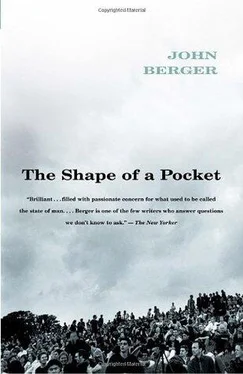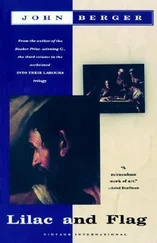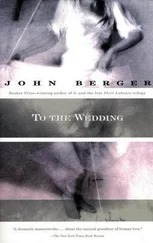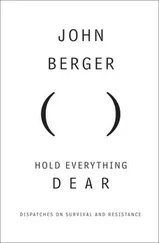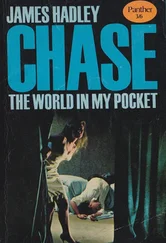So what did he leave behind, if it wasn’t finished masterpieces?
Do we not all dream of being known, known by our backs, legs, buttocks, shoulders, elbows, hair? Not psychologically recognised, not socially acclaimed, not praised, just nakedly known. Known as a child is by its mother.
One might put it like this. Degas left behind something very strange. His name. His name, which, thanks to the example of his drawings, can now be used as a verb. ‘Degas me. Know me like that! Recognise me, dear God! Degas me.’
8 Drawing: Correspondence with Leon Kossoff
Dear Leon,
I still remember clearly the first time I visited you in your studio, or the room you were then using as a studio. It was some 40 years ago. I remember the debris and the omnipresent hope. The hope was strange because its nature was that of a bone, buried in the earth by a dog.
Now the bone is unburied and the hope has become an impressive, achievement. Except that the last word is wrong, don’t you think? To hell with achievement and its recognition, which always comes too late. But a hope of redemption has been realised. You have saved much of what you love.
All this is best not said in words. It’s like trying to describe the flavour of garlic or the smell of mussels. What I want to ask you about is the studio.
The first thing painters ask about a studio-space usually concerns the light. And so one might think of a studio as a kind of conservatory or observatory or even lighthouse. And of course light is important. But it seems to me that a studio, when being used, is much more like a stomach. A place of digestion, transformation and excretion. Where images change form. Where everything is both regular and unpredictable. Where there’s no apparent order and from where a well-being comes. A full stomach is, unhappily, one of the oldest dreams in the world. No?
Perhaps I say this to provoke you, because I’d like to know what images a studio (where images are made) suggests to you — you who have spent many years alone in one. Tell me …
John
Dear John,
Thank you for your letter. Almost 40 years ago you wrote a very generous piece on my work, The Weight. It was the first and, for many years, the only constructive and positive response to the work, and I never thanked you. But I have never forgotten it, and, in the strange time I am living through, now, of having to gather my work (and my life I suppose) together for a first retrospective, I am frequently reminded of it.
All the things you say about the studio are true and the place I work in is much the same as it has always been. A room in a house — a much larger house. There is mess and paint everywhere on the walls — on the floor.
Brushes are drying by the radiator, unfinished paintings are on the walls with drawings of current subjects. There is a place for the model to sit in a corner and a few reproductions on the wall that I’ve had most of my painting life. I don’t worry much about the light, sometimes it can be awkward as the room faces due south, then I turn the painting round or start a new version. I seem engaged in an endless cycle of activities. For the best part of 40 years I have been left alone but recently, owing to extra exposure and studio visits, the place has become like a deserted ship.
Do you remember when we first saw the revealing and moving photographs of Brancusi’s and Giacometti’s studios in the 1950s? It was a special time. Now every book on every artist includes a photograph of the studio. It has become a familiar stage-set for the artist’s work. Has the activity become more important than the resulting image, or does the image need the confirmation of the studio and the myth of the artist because it’s not strong enough to be on its own?
I don’t know what the work will look like when it finally appears on the walls of the Tate. The main thing that has kept me going all these years is my obsession that I need to teach myself to draw. I have never felt that I can draw and as time has passed this feeling has not changed. So my work has been an experiment in self-education.
Now, after all this drawing, if I stand before a vast Veronese I experience the painting as an exciting exploratory drawing in paint. Or, looking at Velazquez’s Pope Innocent X , at present in the National Gallery, I wonder, after moving to the nearby early Christ after Flagellation , at the transformation of his capacity to draw with paint. Recently I saw a book of Fayum portraits [the Egyptian mummy paintings] and, thinking about their closeness to Cezanne and the best Picasso, I am reminded of the importance of drawing to all art since the beginning of time. I know this is all familiar to you — even simplistic — but it’s where I begin and end.
The exhibition will commence with the thick painting you wrote about. Will the later, relatively lighter and thinner work be seen to have emerged out of my need to relate to the outside world by teaching myself to draw?
Yours, Leon
Dear Leon,
I don’t, of course, find your thought about drawing ‘simplistic’. I too have been looking at that extraordinary book of Fayum portraits. And what first strikes me, as it must strike everybody, is their thereness. They are there in front of us, here and now. And that’s why they were painted — to remain here, after their departure.
This quality depends on the drawing and the complicity, the inter-penetrations, between the head and the space immediately around it. (Perhaps this is partly why we think of Cezanne.) But isn’t it also to do with something else — which perhaps approaches the secret of this so mysterious process which we call drawing — isn’t it also to do with the collaboration of the sitter? Sometimes the sitter was alive, sometimes dead, but one always senses a participation, a will to be seen, or, maybe, a waiting-to-be-seen.
It seems to me that even in the work of a great master, the difference between his astounding works and the rest, always comes down to this question of a collaboration with the painted, or its absence.
The romantic notion of the artist as creator eclipsed — and today the notion of the artist as a star still eclipses — the role of receptivity, of openness in the artist. This is the pre-condition for any such collaboration.
So-called ‘good’ draughtsmanship always supplies an answer. It may be a brilliant answer (Picasso sometimes), or it may be a dull one (any number of academics). Real drawing is a constant question, is a clumsiness, which is a form of hospitality towards what is being drawn. And, such hospitality once offered, the collaboration may sometimes begin.
When you say: ‘I need to teach myself to draw,’ I think I can recognise the obstinacy and the doubt from which that comes. But the only reply I can give is: I hope you never learn to draw! (There would be no more collaboration. There would only be an answer.)
Your brother Chaim (in the larger 1993 portrait) is there like one of the ancient Egyptians. His spirit is different, he has lived a different life, he is awaiting something different. (No! that’s wrong, he’s awaiting the same thing but in a different way.) But he is equally there. When somebody or something is there, the painting method seems to be a detail. It is like the self-effacement of a good host.
Pilar (1994) is there to a degree that makes us forget every detail. Through her body, her life was waiting to be seen, and it collaborated with you, and your drawing in paint allowed that life to enter.
You don’t draw in paint in the same way as Velazquez — not only because times have changed, but also because time has changed, your openness is not the same either (he with his open scepticism, you with your fervent need for closeness), but the riddle of collaboration is still similar.
Читать дальше
